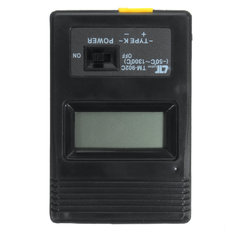Introduction to the TM-902C
Measuring temperature with a thermocouple
The TM-902C is a less than € 5.00 temperature meter that works according to the thermocouple principle. We will not discuss the operation of such meters here. The TM-902C we bought has printed a manufacturer's logo of Lutron, but there are several models of this thermocouple meter in circulation. If you order one, you should pay attention that there is a slide switch as ON/OFF switch and no push button. According to reports on the internet, the model with a push button quickly drains its battery even when the button is turned off.
A very small measuring point without temperature loss
The useful thing about a thermocouple temperature meter is that the actual measuring point is very small, namely the weld between two metal wires. With this small sensitive point you can measure the temperature of a transistor, for example, without the thermal mass of the probe influencing the temperature of the part. The thermal inertia of such a thermocouple is low. The weld is already at the temperature of the part to be measured after just a few seconds.
 |
| The small point, where the two wires are welded together, is the actual thermocouple. (© 2018 Jos Verstraten) |
The TM-902C is offered in various configurations, with slide switch or push button, with one or two thermocouples and powered from a 9 V battery or from two 1.5 V button cells. The set we ordered at Banggood is shown in the picture below. All you need is a 9 V block battery.
The thermocouple is a type-K, which means that the torque is composed of chromel-alumel with an output voltage of 40.4 µV/°C.
This thermocouple can also be ordered separately, for example as a spare, and costs only € 1.30.
 |
| The package, delivered for less than € 5.00. (© Jos Verstraten) |
According to the supplier, the TM-902C has the following specifications:
- Measuring range: -50 °C to +1300 °C
- Measuring resolution: -0.1 °C
- Accuracy -50 °C to -40 °C: ±4 °C
- Accuracy 0 °C to +20 °C: ±2 °C
- Accuracy +20 °C to +500 °C: ±1 °C
- Accuracy +500 °C to +750 °C: ±2 °C
- Length of the measuring cable: 95 cm
- Power supply voltage: 9 Vdc block battery
- Weight: 75 g
- Dimensions: 18 mm x 72 mm x 108 mm
Comments on these specifications
The specified measuring range is a joke. After all, if you look at the specifications of the supplied thermocouple, you will see that a measuring range of -50 °C to only +400 °C is specified. Of course, this is more than enough for use in the electronics lab.

The electronics of the TM-902C
After unscrewing the housing you can see a small PCB. All the electronics are apparently housed in one chip. At the top you can see the contacts, which are needed to control the LCD-display.
 |
| The electronics in the TM-902C. (© 2018 Jos Verstraten) |
Working with the TM-902C
Very simple operation
The operation is very simple. Plug the thermocouple into the connector, paying attention to the plus and minus of the probe. Switch on the device and place the tip of the thermocouple in the closest possible thermal contact with the object whose temperature you want to measure. After only two seconds at most, you will see that the reading is stabilizing and the thermocouple has taken over the temperature of the object. Because the cable is rather weak, you cannot exert much pressure on the thermocouple and it is questionable whether the couple makes good thermal contact with the object to be measured.

That is why we strongly recommend the use of heat conducting paste. This is contained in a kind of hypodermic syringe and you can apply a little of this paste to the part whose temperature you want to measure. Then press the tip of the thermocouple into the paste and you can be sure that there is good thermal contact between the thermocouple and the part. Google on 'Thermal Grease' and you will find enough suppliers of such products.
 |
| With heat conducting paste you are assured of a good thermal contact between thermocouple and part. (© 2018 Jos Verstraten) |
Of course we were very curious about the accuracy of such a cheap temperature meter. That is really not that bad, just look at the graph below. We have compared the temperature measured with the TM-902C with that of a professional thermocouple meter from Lascar Electronics. We measured between -18 °C and +100 °C. We found the maximum deviation, as the specifications already suggest, at temperatures below the freezing point of water. At a temperature of -18.0 °C, the reading on the TM-902C was -22.8 °C. That is 0.8 °C more error than the specifications indicate. At all other measuring points, the deviation found was completely within the specifications. Two examples, in which the laws of physics leave no room for misunderstanding about the real temperature:
- Freezing point for distilled water: -0.6 °C
- Boiling point for distilled water: +99,5 °C
 |
| A test of the accuracy of the TM-902C. (© 2018 Jos Verstraten) |

TM-902C LCD K-Type Temperature Meter

